
Peripatric speciation is a mode of speciation in which a new species is formed from an isolated peripheral population. Since peripatric speciation resembles allopatric speciation, in that populations are isolated and prevented from exchanging genes, it can often be difficult to distinguish between them. Nevertheless, the primary characteristic of peripatric speciation proposes that one of the populations is much smaller than the other. The terms peripatric and peripatry are often used in biogeography, referring to organisms whose ranges are closely adjacent but do not overlap, being separated where these organisms do not occur—for example on an oceanic island compared to the mainland. Such organisms are usually closely related ; their distribution being the result of peripatric speciation.

Peter Hamilton Raven is an American botanist and environmentalist, notable as the longtime director, now President Emeritus, of the Missouri Botanical Garden.

Clarkia breweri is a species of wildflower known by the common names fairy fans and Brewer's clarkia. This rare plant is endemic to California, where it is known from only seven counties in the central part of the state. It produces short stems under 20 centimeters in height and sparse, narrow leaves. The distinctive flowers have four pink to lavender petals, each about 2 centimeters long and wide, with 3 odd lobes, the middle lobe being long and spoon-shaped.

Clarkia gracilis is a species of wildflower known by the common name slender clarkia. This plant is native to the US states of California, Oregon, and Washington, where it is found in coastal, foothill, valley, and low-elevation mountain habitats. The plant is variable across subspecies but is generally an erect slender stem with a few sparse, narrow leaves several centimeters long. It bears an inflorescence of drooping buds which open into bowl-shaped flowers with pinkish lavender petals 1 to 4 centimeters long and bearing a red or white splotch which can appear in the center or at the base of the petal, depending on the subspecies.
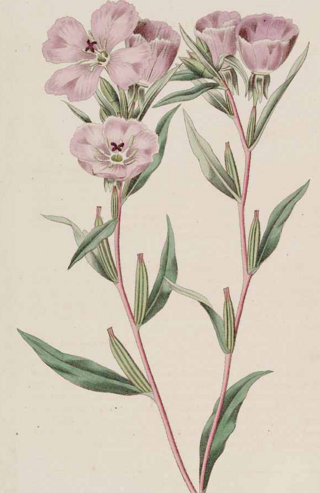
Clarkia purpurea is a species of wildflower known by the common names winecup clarkia, winecup fairyfan, and purple clarkia.
Clarkia australis is a species of flowering plant in the evening primrose family known by the common name Small's southern clarkia. It is endemic to California, where it grows in the forests of the central Sierra Nevada. It is an uncommon species threatened by such forest activities as logging. This annual herb produces a slender, erect stem approaching a meter in height. The leaves are widely linear in shape and borne on short petioles. The top of the stem is occupied by the tall inflorescence, which bears hanging buds that open from the lowest upward so that there are several closed buds above open flowers. The sepals do not remain fused as the flower opens. The petals are diamond-shaped and sometimes lobed and curling at the tip. They are mottled or spotted lavender, purple, and reddish in color, and each is up to 1.5 centimeters long. There are 8 long stamens tipped with large anthers bearing blue-gray pollen. The stigma protrudes past the anthers.
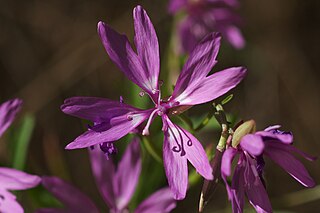
Clarkia biloba is a species of flowering plant in the evening primrose family known by the common name twolobe clarkia and two lobed clarkia.
Clarkia borealis is a rare species of flowering plant in the evening primrose family known by the common name northern clarkia. It is endemic to California, where it is known from the forests of the southern Klamath Range and the southernmost Cascade Range foothills. It is an annual herb growing an erect, slender stem. The leaves are oval in shape and borne on short petioles. The top of the stem is occupied by the inflorescence, in which the lowest flowers open first and hanging, pointed flower buds occur at nodes at the top. The sepals separate as the flower blooms, revealing purplish pink petals. Each petal is between 1 and two centimeters long, elongated triangular to semicircular in shape, and sometimes flecked with dark purple. There are 8 stamens with anthers bearing blue-gray pollen, and a protruding stigma.
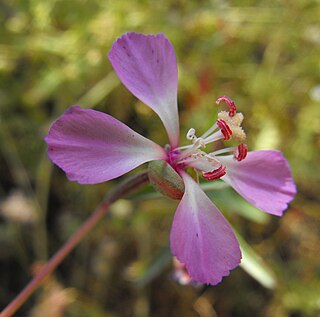
Clarkia delicata is a rare species of flowering plant in the evening primrose family known by the common names Campo clarkia and delicate clarkia. It is native to northern Baja California and adjacent San Diego County, California, where it grows in the woodland and chaparral of the Peninsular Ranges. This is an annual herb producing an erect stem just over half a meter in maximum height. The leaves are oval or widely lance-shaped, up to 4 centimeters long, and borne on very short petioles. The top of the stem is occupied by the inflorescence, in which the lower flowers open while the upper buds hang closed. The sepals remain fused as the flower blooms from one side. Each unlobed oval petal is about a centimeter long and pink to pinkish-lavender. There are 8 stamens, some with large orange anthers and some with smaller, paler anthers. There is also a protruding stigma with four large, fuzzy lobes.

Clarkia exilis is a small herbaceous annual plant of western North America. It is an uncommon species in the evening primrose family known by the common names Kern River clarkia and slender clarkia.

Clarkia franciscana is a rare species of flowering plant in the evening primrose family known by the common name Presidio clarkia. It is endemic to the San Francisco Bay Area of California, where it is known only from two populations at the Presidio of San Francisco and three occurrences in Oakland. The plant is known only from serpentine soils.

Clarkia imbricata is a rare species of flowering plant in the evening primrose family known by the common name Vine Hill clarkia. It is endemic to Sonoma County, California, where it is known from only one remaining natural occurrence near Vine Hill. A second natural population located on private land was extirpated when the owners plowed up the soil crust. The California Native Plant Society has established a third population from cuttings and is tending it in a reserve. This is a federally listed endangered species.
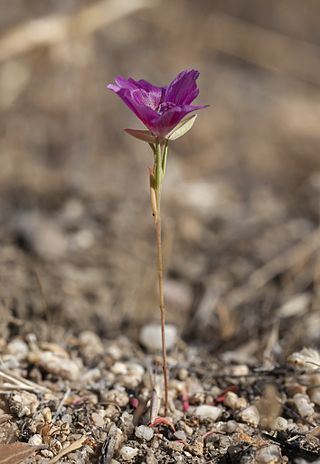
Clarkia jolonensis is an uncommon species of flowering plant in the evening primrose family known by the common name Jolon clarkia. It is endemic to Monterey County, California, where it is known from the woodlands of the Central Coast Ranges.
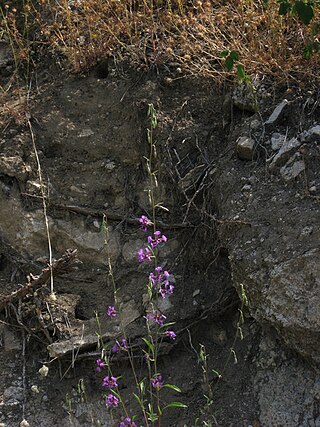
Clarkia mosquinii is a rare species of flowering plant in the evening primrose family known by the common name Mosquin's clarkia. It is endemic to California, where it is known only from the northern Sierra Nevada foothills at the border between Butte and Plumas Counties. It was thought to be extinct until it was rediscovered in 1991. It is an erect annual herb often exceeding half a meter in height. The oval or lance-shaped leaves are 2 to 5 centimeters long. The inflorescence bears opening flowers below a series of clusters of closed, hanging flower buds. The sepals all separate as the flower blooms. The diamond-shaped petals are one to two centimeters long light to medium purple in color, and sometimes speckled with reddish purple.
Clarkia rostrata is a species of flowering plant in the evening primrose family known by the common name beaked clarkia.

Clarkia springvillensis is a rare species of flowering plant in the evening primrose family known by the common name Springville clarkia. It is endemic to central Tulare County, California, where it is known from fewer than 20 occurrences around Springville. It is a federally listed threatened species.
Clarkia tembloriensis is a rare species of flowering plant in the evening primrose family, known by the common name Temblor Range clarkia and belonging to the Onagraceae family.

Clarkia williamsonii is a species of flowering plant endemic to California, where it is known from the forests and woodlands of the northern and central Sierra Nevada foothills.

Leslie David Gottlieb (1936–2012) was a United States biologist described by the Botanical Society of America as "one of the most influential plant evolutionary biologists over the past several decades". He was employed at the University of California, Davis for 34 years, and published widely. In addition to his primary work in plant genetics, Gottlieb was an advocate for rare and endangered plant conservation.

Frank Harlan Lewis was an American botanist, geneticist, taxonomist, systematist, and evolutionist who worked primarily with plants in the genus Clarkia. He is best known for his theories of "catastrophic selection" and "saltational speciation", which are closely aligned with the concepts of quantum evolution and sympatric speciation. The concepts were first articulated in 1958 by Lewis and Peter H. Raven, and later refined in a 1962 paper by Lewis in which he coined the term "catastrophic selection". In 1966, he referred to the same mechanism as "saltational speciation".
















